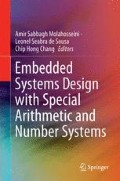Abstract
This chapter introduces the problem of non-modular operations in the Residue Number System (RNS) and presents some recent approaches for their effective implementation. The approaches are based on specific functions defined from the RNS to the Integers that show mathematical properties useful to support the implementation of non-modular operations, like magnitude comparison and residue-to-binary conversion. In particular, two different functions defined from the RNS to the Integers are discussed: the ‘diagonal functions’ and the ‘quotient functions’. Through the paper the new implementations of non-modular operations in the RNS are described and their effectiveness is analysed with respect to traditional techniques in the literature.
Access this chapter
Tax calculation will be finalised at checkout
Purchases are for personal use only
Abbreviations
- - :
-
m 1,m 2,…,m n : set of pairwise relatively prime moduli (n integer, n ≥ 2)
- - :
-
\( M={\displaystyle \prod_{i=1}^n{m}_i} \)
- - :
-
I = [0,M − 1]: dynamic range of the RNS (set of integers)
- - :
-
\( {X}_i={\left|X\right|}_{m_i} \): the least positive residue of X modulo m i , i = 1,2,..,n
- - :
-
\( {M}_i=\frac{M}{m_i} \), i = 1,2,…,n
- - :
-
\( \mathit{SQ}={\displaystyle \sum_{i=1}^n{M}_i} \): the ‘diagonal modulus’ of the RNS
- - :
-
\( {J}_{a,b}={\left|\frac{1}{a}\right|}_b \): the multiplicative inverse of a modulo b (i.e. \( \vert a\cdot {\left|\frac{1}{a}\right|}_b{\vert}_b=1 \))
- - :
-
⌊a⌋: the largest integer not exceeding a
- - :
-
⌈b⌉: rounding to a higher integer
- - :
-
≡: modular congruence
- - :
-
MOMA (n, W): multi-operand modulo W adder for n operands.
References
S. Szabó, R.I. Tanaka, Residue arithmetic and its applications to computer technology (McGraw-Hill, New York, 1967)
F.J. Taylor, Residue arithmetic: a tutorial with examples. Computer 17(5), 50–62 (1984)
A.A. Albert, Fundamental concepts of higher algebra (University of Chicago Press, Chicago, 1956)
S. Andraos, H. Ahmed, A new efficient memoryless residue to binary converter. IEEE Trans. Circ. Syst. 35, 1441–1444 (1988)
K.M. Ibrahim, S.N. Saloum, An efficient residue to binary converter design. IEEE Trans. Circ. Syst. CAS-35, 1156–1158 (1988)
S. Chen, S. Wei, Weighted-to-residue and residue-to-weighted converters with three-moduli (2n − 1, 2n, 2n + 1) signed-digit architectures, in Proceedings of 2006 IEEE International Symposium on Circuits and Systems (ISCAS 2006), Island of Kos, Greece, 21–24 May 2006
W.W. Swamy, M.N.S. Ahmad, M.O.Y. Wang, A high-speed residue-to-binary converter for three-moduli (2k − 1, 2k − 1, 2n−1 − 1) RNS and a scheme for its VLSI implementations. IEEE Trans. Circuits Syst. II: Express Briefs 47(12), 1576–1581 (2000)
B. Cao, C.-H. Chang, T. Srikanthan, A residue-to-binary converter for a new five-moduli set. IEEE Trans. Circuits Syst. I 54(5), 1041–1049 (2007)
B. Cao, T. Srikanthan, C.-H. Chang, Design of residue-to-binary converter for a new 5-moduli superset residue number system, in Proceedings of the International Symposium on Circuits and Systems (ISCAS 2004), Vancouver, Canada, vol. 2, pp. II-841-4, 23–26 May 2004
A. Skavantzos, M. Abdallah, Implementation issues of the two-level residue number system with pairs of conjugate moduli. IEEE Trans. Signal Process. 47(3), 826–838 (1999)
B. Phillips, Scaling and reduction in the residue number system with pairs of conjugate moduli. in Proceedings of the 37th Asilomar Conference on Signals, Systems and Computers, vol. 2, pp. 2247–2251, 2003
S.J. Piestrak, Design off residue generators and multioperand modular adders using carry-save adders. IEEE Trans. Comput. 423(1), 68–77 (1994)
S.J. Piestrak, A high-speed realization of a residue to binary number system converter. IEEE Trans. Circuits Syst. II 42(10), 661–663 (1995)
S.J. Piestrak, A note on RNS architectures for the implementation of the diagonal function. Inform. Process. Lett. 115(4), 453–457 (2015)
J. Gonnella, The application of core functions to residue number system. IEEE Trans. Signal Process. 39(1), 69–75 (1991)
I.J. Akushskii, V.M. Burcev, I.T. Pak, A new positional characteristic of nonpositional codes and its applications, in Coding Theory and the Optimization of Complex Systems, V.M.Amerbsev ed., Kazah, 1977
D.D. Miller, R.E. Altschul, J.R. King, J.N. Polky, analysis of the residue class core function of akushskii, burcev and pak, in Residue Number System Arithmetic, Modern Applications in Digital Signal Processing, ed. by M.A.Soderstrand et al. IEEE Press,Paper 7-2, pp. 390–401
G. Dimauro, S. Impedovo, G. Pirlo, A new technique for fast numbers comparison in the residue number system. IEEE Trans. Comput. 42(5), 608–612 (1993)
G. Dimauro, S. Impedovo, G. Pirlo, A new magnitude function for fast numbers comparison in the residue number system. Microprocess. Microprogram. 35(1–5), 97–104 (1992)
G. Dimauro, S. Impedovo, G. Pirlo, A. Salzo, RNS architectures for the implementation of the diagonal function. Inform. Process. Lett. 73, 189–198 (2000)
G. Dimauro, S. Impedovo, R. Modugno, G. Pirlo, R. Stefanelli, Residue-to-binary conversion by the quotient function. IEEE Trans. Circuits Syst—Part II 50(8), 488–493 (2003)
G. Pirlo, D. Impedovo, A new class of monotone functions of the residue number system. Int. J. Math. Models Methods Appl. Sci. 7, 802–809 (2013)
P.V. Ananda Mohan, RNS to binary conversion using diagonal function and pirlo and impedovo monotonic function. Circuits Syst. Signal Process. 35(3), 1063–1076 (2016)
Author information
Authors and Affiliations
Corresponding author
Editor information
Editors and Affiliations
Rights and permissions
Copyright information
© 2017 Springer International Publishing AG
About this chapter
Cite this chapter
Pirlo, G. (2017). Non-Modular Operations of the Residue Number System: Functions for Computing. In: Molahosseini, A., de Sousa, L., Chang, CH. (eds) Embedded Systems Design with Special Arithmetic and Number Systems. Springer, Cham. https://doi.org/10.1007/978-3-319-49742-6_3
Download citation
DOI: https://doi.org/10.1007/978-3-319-49742-6_3
Published:
Publisher Name: Springer, Cham
Print ISBN: 978-3-319-49741-9
Online ISBN: 978-3-319-49742-6
eBook Packages: EngineeringEngineering (R0)

